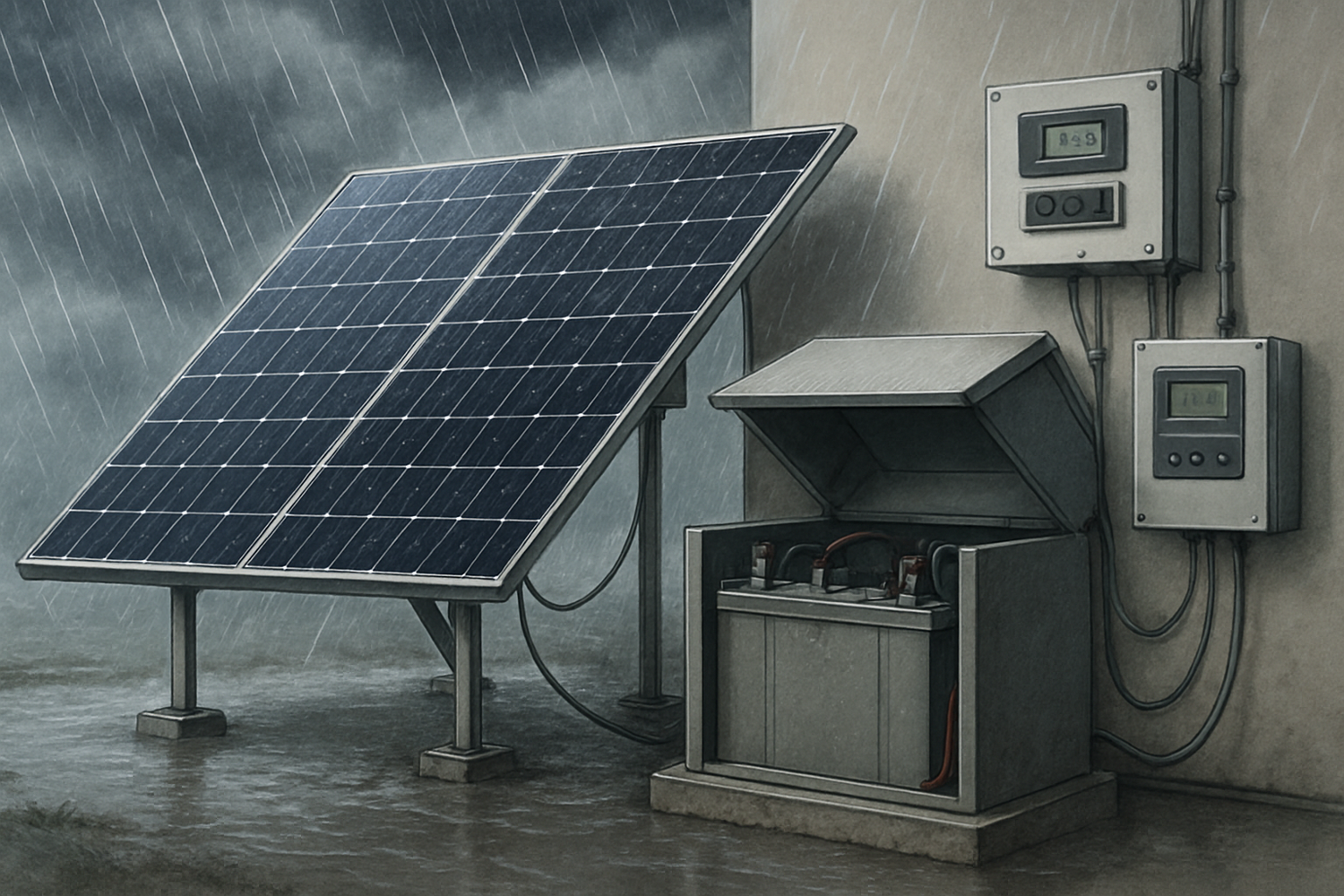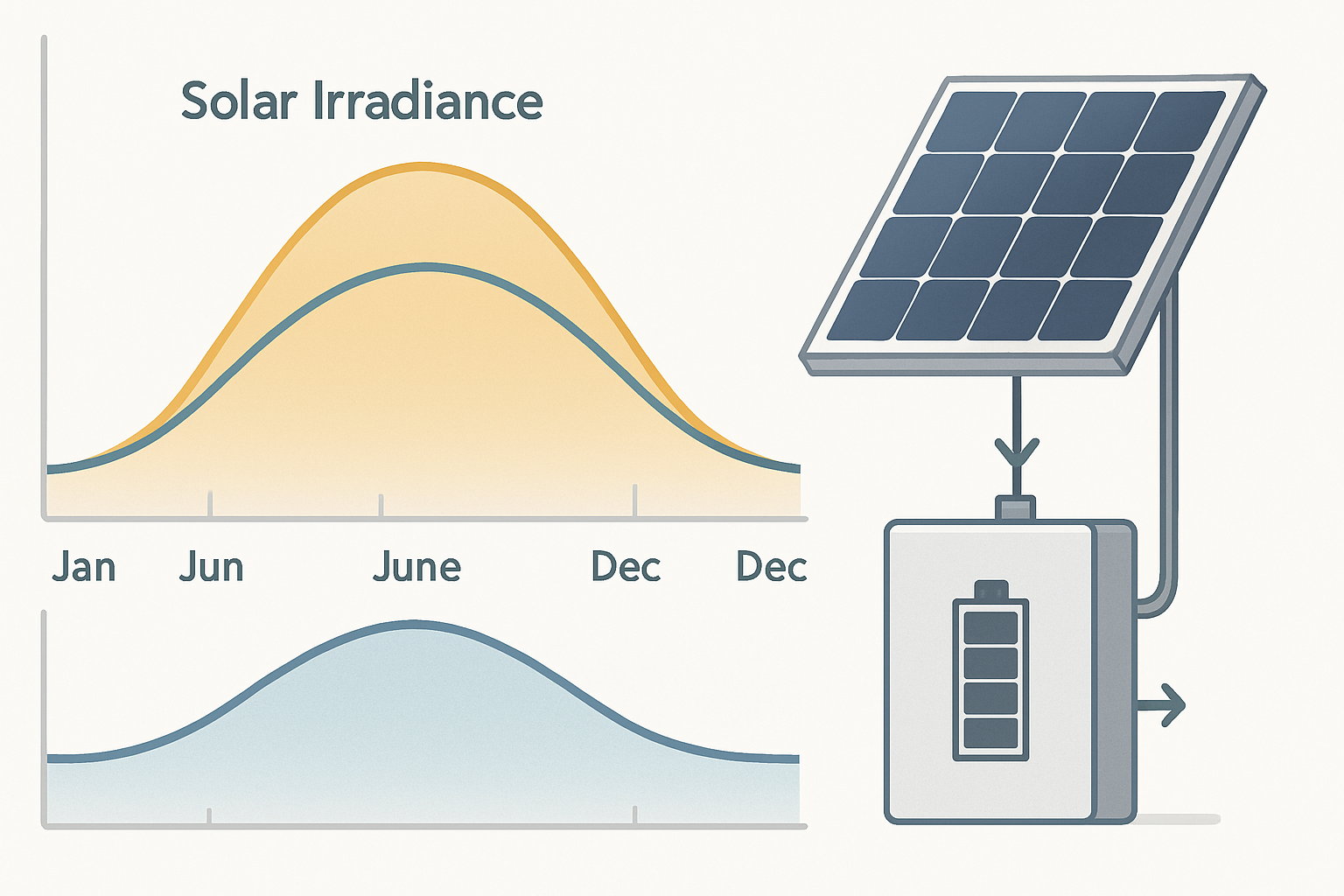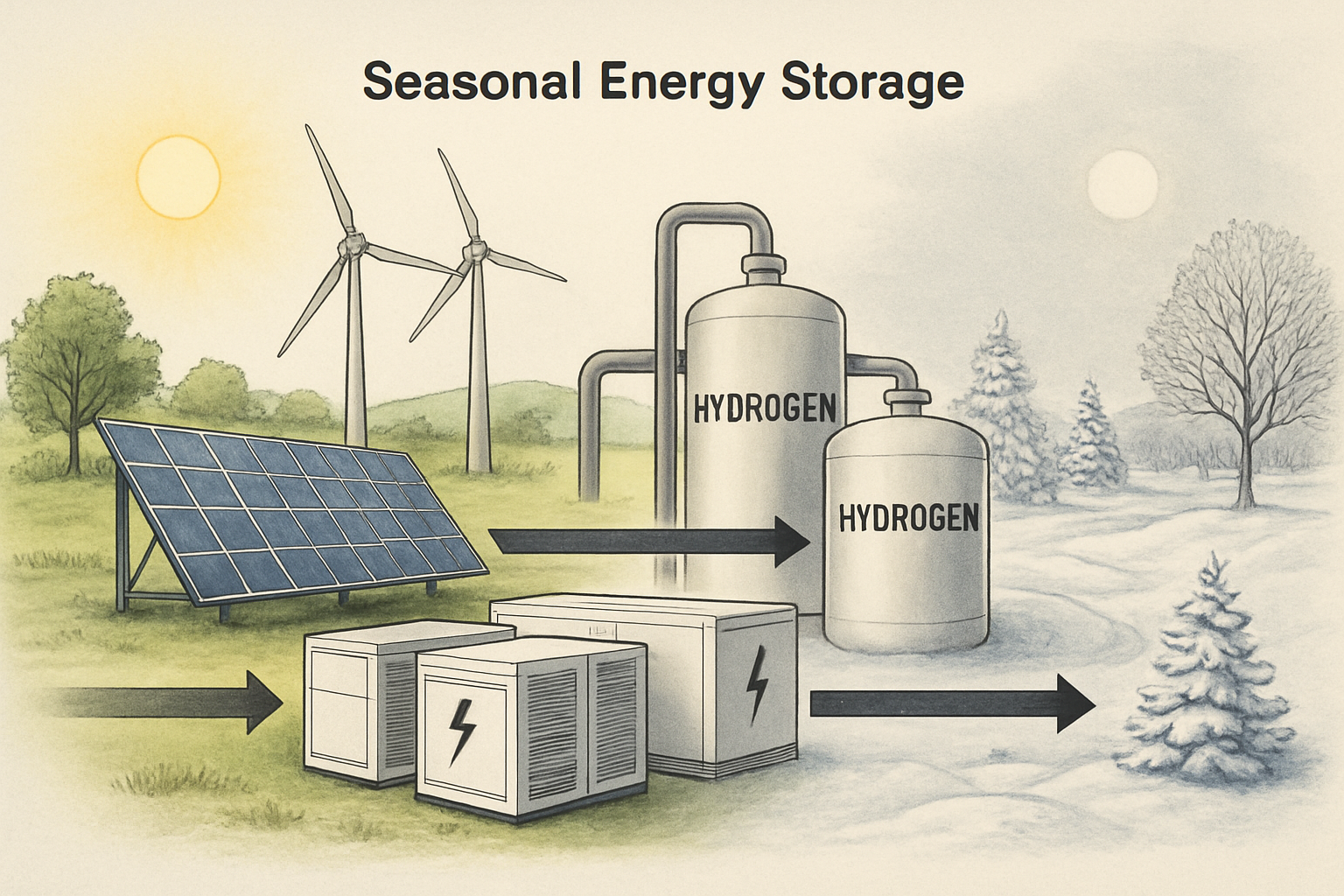Monsoon seasons bring unique challenges that can cripple poorly designed off-grid systems. Extended periods of heavy cloud cover, high humidity, and equipment stress test every component of your energy independence setup. Smart system design transforms these seasonal obstacles into manageable operational parameters.
This comprehensive guide reveals proven engineering strategies for monsoon-ready off-grid systems that maintain reliable power throughout the wettest months. You'll discover capacity planning methodologies, weatherproofing techniques, and intelligent load management approaches that ensure uninterrupted energy supply when traditional grid connections fail.
Understanding Monsoon Energy Challenges
Monsoon seasons dramatically alter energy production and consumption patterns. Solar irradiance drops by 60-80% during heavy cloud cover, while humidity increases equipment maintenance requirements and affects battery performance. According to DOE's Solar Forecasting Platform research, cloud cover creates the most significant variability in solar generation, making accurate capacity planning essential for reliable off-grid operation.
Temperature fluctuations during monsoons create additional stress on lithium battery systems. LiFePO4 batteries experience capacity variations of 10-15% across typical monsoon temperature ranges, requiring careful thermal management and capacity derating calculations.
Precipitation Impact on Solar Production
Heavy rainfall reduces solar panel efficiency through multiple mechanisms. Water droplets scatter incoming light, while persistent cloud cover blocks direct solar radiation. Field data shows solar production can drop to 15-25% of rated capacity during peak monsoon periods, lasting 3-7 consecutive days in severe weather systems.
Dust and debris accumulation during pre-monsoon periods further reduces panel efficiency. Regular cleaning protocols become critical, as dirty panels lose an additional 5-10% efficiency before seasonal rains begin.
Equipment Vulnerability Factors
High humidity accelerates corrosion in electrical connections and reduces insulation effectiveness. Inverter cooling systems work harder in humid conditions, potentially triggering thermal derating that reduces available power output by 10-20%. Proper enclosure design and ventilation strategies mitigate these environmental stresses.

Strategic Capacity Planning for Extended Low-Sun Periods
Effective monsoon system design requires sophisticated capacity calculations that account for consecutive low-production days. Standard sizing methodologies often underestimate storage requirements during extended weather events, leading to system failures when reliability matters most.
Historical weather data analysis reveals monsoon patterns typically include 5-10 day periods with less than 20% normal solar production. Your battery bank must support full loads during these extended periods while maintaining sufficient reserve capacity for unexpected equipment failures.
Battery Bank Sizing Methodology
Calculate monsoon battery requirements using this proven formula: Required capacity = (Daily load × Autonomy days × Temperature derating factor) ÷ Depth of discharge limit. For monsoon applications, use minimum 7-day autonomy with 1.15 temperature derating factor and 80% maximum DOD for LiFePO4 systems.
| System Size | Typical Daily Load | Monsoon Battery Capacity | Recommended Configuration |
|---|---|---|---|
| Small Cabin | 5 kWh | 45 kWh | 48V, 900Ah LiFePO4 |
| Medium Home | 15 kWh | 135 kWh | 48V, 2800Ah LiFePO4 |
| Large Residence | 30 kWh | 270 kWh | 48V, 5600Ah LiFePO4 |
Solar Array Oversizing Strategies
Monsoon-ready systems benefit from 150-200% solar array oversizing compared to standard calculations. This oversizing compensates for reduced irradiance and provides adequate charging current during partially cloudy conditions. The additional panels generate sufficient power even when production drops to 30-40% of clear-sky values.
Panel orientation becomes crucial during monsoon seasons. Installing arrays at multiple tilt angles captures more diffuse light during overcast conditions. A combination of steep-tilt panels (45-60°) for morning/evening light and moderate-tilt panels (25-35°) for midday production optimizes energy capture throughout variable weather patterns.
Weatherproof Storage and Protection Systems
Monsoon conditions demand robust protection strategies that go beyond basic weather resistance. Proper enclosure design, ventilation systems, and moisture control prevent equipment degradation and maintain optimal performance throughout extended wet periods.
LiFePO4 battery systems require specific environmental controls during monsoon seasons. Temperature regulation becomes critical as humid conditions affect thermal management, while moisture ingress can damage battery management systems and reduce cycle life.
Enclosure Design Requirements
Battery enclosures must achieve minimum IP65 rating for monsoon applications, with NEMA 4X certification preferred for coastal or high-humidity environments. Proper enclosure design includes condensation management through controlled ventilation and desiccant systems that maintain internal humidity below 60%.
Thermal management systems require redundancy during monsoon periods. Primary cooling systems may operate less efficiently in high humidity, making backup ventilation or active cooling essential for maintaining optimal battery temperatures between 15-25°C.
Electrical Protection Protocols
Enhanced grounding systems become critical during monsoon seasons when lightning risk increases significantly. Proper surge protection devices (SPD) at multiple system levels protect against both direct strikes and induced voltage surges from nearby lightning activity.
Connection integrity requires special attention in humid conditions. All electrical connections need dielectric grease application and regular inspection schedules. Corrosion-resistant materials like tinned copper and stainless steel hardware prevent degradation that could cause system failures during critical periods.
Intelligent Load Management During Weather Events
Smart load management transforms monsoon challenges into manageable operational parameters. Automated systems prioritize critical loads while deferring non-essential consumption during low-production periods, extending battery autonomy and maintaining essential services.
According to IEA's research on integrating solar and wind, system-friendly renewable energy deployment includes smart operational strategies that support overall system outcomes. This principle applies directly to off-grid monsoon management through intelligent load scheduling and demand response protocols.
Load Prioritization Frameworks
Implement three-tier load classification: critical (lighting, refrigeration, communications), essential (water pumps, heating/cooling), and deferrable (washing machines, entertainment systems). Automated switching systems disconnect lower-priority loads when battery state-of-charge drops below predetermined thresholds.
Smart inverters with programmable load control enable sophisticated demand management. These systems monitor battery voltage, weather forecasts, and historical consumption patterns to make intelligent decisions about load connectivity and power allocation.
Predictive Energy Management
Weather forecast integration allows proactive load management before monsoon events arrive. Systems can pre-charge batteries, defer non-critical loads, and optimize generator scheduling based on predicted weather patterns and solar production forecasts.
Modern battery management systems provide state-of-charge predictions that account for temperature effects and aging factors. This data enables precise load management decisions that maximize system autonomy during extended low-production periods.
Backup Integration and Hybrid Solutions
Reliable monsoon operation often requires backup power integration that complements solar and battery systems. Generator systems, fuel cells, or micro-hydro installations provide additional energy sources during extended weather events when solar production remains insufficient.
Hybrid system design balances renewable energy priorities with practical reliability requirements. Smart charging algorithms optimize generator runtime, battery cycling, and fuel consumption while maintaining essential services throughout monsoon periods.
Generator Integration Strategies
Properly sized generators should provide 120-150% of peak load capacity while efficiently charging battery banks. Automatic start systems monitor battery state-of-charge and weather conditions to minimize fuel consumption while ensuring adequate backup power availability.
Generator scheduling algorithms consider battery charging efficiency, fuel costs, and noise restrictions. Optimal charging occurs during specific voltage ranges that maximize battery acceptance rates while minimizing generator runtime and fuel consumption.
Alternative Energy Sources
Micro-hydro systems provide excellent monsoon complementarity where water sources are available. Small turbines generate consistent power during rainy periods when solar production drops, creating naturally balanced hybrid systems that reduce battery cycling and generator dependence.
Wind power integration offers another complementary option, particularly in coastal or elevated locations where monsoon winds provide consistent energy. Small wind turbines can generate significant power during storm systems when solar panels produce minimal output.
Monitoring and Maintenance Protocols
Comprehensive monitoring systems enable proactive maintenance and early problem detection during challenging monsoon conditions. Remote monitoring capabilities allow system optimization without physical site visits during severe weather periods.
Preventive maintenance schedules must account for monsoon-specific requirements including increased inspection frequency, moisture control verification, and equipment cleaning protocols that maintain optimal system performance.
Performance Monitoring Systems
Advanced monitoring platforms track multiple parameters including solar production, battery state-of-charge, load consumption, and environmental conditions. Alert systems notify operators of performance degradation or potential equipment failures before they impact system reliability.
Data logging capabilities enable post-monsoon analysis that improves future system design and operation. Historical performance data reveals actual versus predicted energy patterns, helping refine capacity calculations and load management strategies.
Maintenance Scheduling
Pre-monsoon preparation includes comprehensive system inspections, connection tightening, and preventive component replacement. During monsoon periods, remote monitoring minimizes required site visits while ensuring continued system operation.
Post-monsoon maintenance addresses any degradation or damage that occurred during the wet season. This includes electrical connection inspection, battery performance testing, and equipment cleaning to restore optimal system efficiency.
Achieving Long-Term Monsoon Resilience
Monsoon-ready off-grid systems require careful integration of oversized solar arrays, properly sized battery banks, intelligent load management, and robust backup systems. Success depends on understanding local weather patterns, implementing appropriate safety margins, and maintaining proactive monitoring protocols.
The investment in monsoon-ready design pays dividends through reliable operation when grid power fails and renewable energy faces its greatest challenges. Proper system design transforms seasonal weather variations from operational crises into manageable parameters that support true energy independence.
Your monsoon reliability strategy should evolve based on actual performance data and changing weather patterns. Regular system analysis and incremental improvements ensure continued reliability as climate conditions shift and energy requirements grow over time.





Leave a comment
All comments are moderated before being published.
This site is protected by hCaptcha and the hCaptcha Privacy Policy and Terms of Service apply.